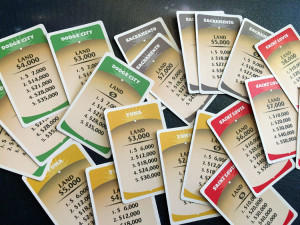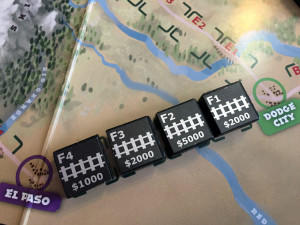 When you see the title and the cover of The Last Spike for the first time, you’re going to think it’s a typical train game where route building, pick-and-and-deliver, or stock manipulation may be the main theme. The Last Spike has route building at its core, but also incorporates set collection and cash management into its gameplay mix.
When you see the title and the cover of The Last Spike for the first time, you’re going to think it’s a typical train game where route building, pick-and-and-deliver, or stock manipulation may be the main theme. The Last Spike has route building at its core, but also incorporates set collection and cash management into its gameplay mix.
The Last Spike is published by Columbia Games and is a game for 2-6 players that plays in 45 minutes. It is a re-imaging/re-packaging of the same game first published in 1976 by designer Tom Daigliesh.
Game Overview:
In The Last Spike, players are attempting to purchase a mix of land cards and collect those in sets in order to enhance money payouts when the sections of tracks between cities are completed. The sections of tracks are completed when players have paid and laid 4 track tiles in a row. Players compete with each other to be the most opportune speculators to attain the most money by the end of the game.
Game Components:

Open the box and one sees a lot of wood which are the currency chips and the track tiles. The currency chips are red, white, and blue and their color signifies their value. The track tiles are chunky black squares each with a printed sticker that contain its cost to lay, track section letter-number, and a track symbol. There is nothing spectacular with the wood pieces, but they support the functionality required by the game.
The land cards are colorful and match the color of the city icon on the game board map. The cards are good quality, contain functional text, and the card backs have the box cover art on them. The game board map and the box cover have art that looks like a painting. The game board has two pictures of train scenes from the 1800s on it. Again there’s nothing spectacular here.
The rulebook is easy to read and is well-formatted. The rules themselves are well-written and the flow is appropriate for this type of game. The downside of the rulebook is that it looks like it was printed with a color laser printer on regular printer paper.
How to Play:
After a starting player is selected, each player draws 4 track tiles to begin the game. Beginning with the start player, play will continue throughout the game in clockwise order.
On each player’s turn, the player does the following 3 actions in order:
- Lays a track tile on the game board map. If a track section is completed, then players collect a Payout.
- Buys one land card. This is optional.
- Draws one new track tile from the draw pile.

When a player is the first player to lay a track tile next to a city, that player collects the “free” land card of the city. Players cannot buy land cards for a city unless the “free” land card has been obtained in this manner. Subsequent land cards bought after the “free” land card has been taken increase in cost, so it is advantageous for players to buy the earliest available land cards.
Payouts are collected by the players who own land cards for the cities that were connected to the completed track section. The size of the payout is determined by the number of land cards a player owns for each connected city. Each city land card contains a table that shows how much the payout is for that number of cards. Players may only sell land cards back to the bank if they cannot afford the cost of laying any of their track tiles. They receive half the cost of the land card rounded up. If need be, they can sell multiple land cards back to the bank to afford the track-laying cost.
The game ends when a continuous route of track tiles has been completed between the cities of Sacramento and St. Louis. The player who laid the last tile (The Last Spike) collects a bonus of $20,000. The player with the most money wins the game. Ties are broken by the player with the highest total cost of the land cards they possess.

Game Experience:
I agree with other folk’s commentary about this game that it feels like the classic game Acquire. The gameplay is similar to Acquire, but much lighter. Players are speculating on which mergers (in this case, track section connections between 2 cities) will bring a larger payout to them than their opponents. Players don’t buy and collect stock, they buy and collect land cards. The “letter-number-marked” tiles are not laid into a grid, but are laid into 4-track sections on the game board.
The decisions that are offered by The Last Spike are driven by the speculation aspect of the game. Do I attempt to collect a majority of land cards for the cities with the most potential payouts? Do I grab a lower costing land card before one of my opponents does the same? Do I attempt to add a tile to a track section to increase the possibility it may be completed by one of my opponents in order to share in the payout?

Of course there is money management to contend with. At the start of the game you feel like you have all the money in the world needed to lay track tiles and buy land cards. But until you share in the first payouts, I liked that money can become tight and a player could be eliminated by becoming bankrupt. This tightness made me stop and think before paying to lay the more expensive tiles or buying the more expensive land cards unless a payout for me was close to becoming a reality.
I enjoyed the aspect of the game where due to the very nature of what a player could do on their turn, the downtime between turns was minimal. A player would be remiss if they did not follow what tiles were played and what land cards were bought leading up to their turn. This information is crucial to bolster one’s success at being the best speculator. This aspect of The Last Spike held my attention throughout each and every game I played. I liked that this game, using similar mechanisms to how Acquire handles game length via a set amount of tiles, potentially plays in the same amount of time or quicker no matter what the player count is. The end game trigger will occur at some point on or before the last tile has been laid.

The Last Spike is a most pleasing romp at all player amounts. I played this game with almost every player count it allows except for the maximum player count of 6. At 2 to 3 players, the game is more casual and becomes a game of outwitting and at times lightly bluffing your opponents. At the higher player counts, one must play extremely tactically and take advantage of land card and payout attainment when presented because those opportunities most likely will not be there when your turn comes back to you.
I found The Last Spike to be highly re-playable due to the randomness of the track tile draws and how the other players sought after the land cards. I certainly did not experience the same or very similar game twice.
Final Thoughts:
I have to say I was pleasantly surprised by the varied gameplay of The Last Spike. To be honest with you, it does not look like much of a game when it is set up on the table, the same feeling when I saw Acquire for the first time. I found The Last Spike to be a good and engaging strategy game and due to its quick gameplay it certainly does not outstay its welcome.
Since The Last Spike supports up to 6 players it can fill a niche for the times you are looking to play a light strategy game with more players than the normal 4 to 5. I would recommend playing this game with novice hobby board gamers. The gameplay concepts are definitely not hard to grasp and I believe players at those levels would enjoy it.
If you’d like to pick up a copy of The Last Spike, you can get it for about $44.
Final Score: 3 Stars – A light and highly re-playable strategy game that plays quick, but will challenge you as a tactician, especially at its higher player totals.
 Hits:
Hits:
• Light, tactical strategy game
• Easy to learn and easy to teach game concepts
• High replay value due to the randomness of track-tile draw and variable player decisions
• Quick gameplay with little downtime
• Supports up to 6 players
Misses:
• Lacks some table appeal
• A little pricey compared to games with similar component quality






















